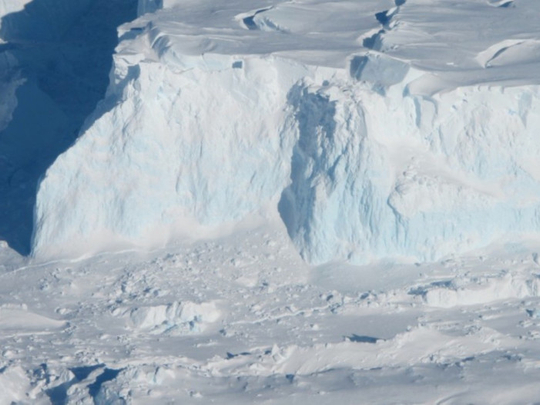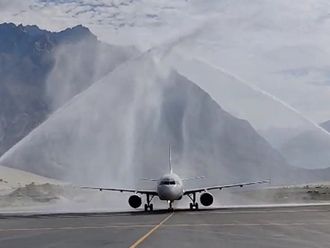
When it comes to climate change, Antarctica is one of the world’s major places of concern, mostly because of the sheer amount of ice it contains — enough to theoretically cause about 200 feet of sea-level rise if it were all to melt — not that anyone thinks that will happen anytime soon. Still, smaller parts could be destabilised, and understanding how the Antarctic ice sheet will react to future climate change is a big priority for scientists.
One important key to building this understanding is studying Antarctic ice shelves, which are large, floating platforms of ice — sometimes spanning hundreds or thousands of square kilometres — that form where an ice sheet meets the ocean.
“They play an incredibly important role in constraining the flow of this land ice into the ocean,” says Luke Trusel, a postdoctoral scholar at the Woods Hole Oceanographic Institution, comparing ice shelves to the “cork in a champagne bottle”. If an ice shelf breaks off, it can unleash a flow of ice into the ocean from the ice sheet behind it, which can contribute to sea-level rise in a major way. Indeed, without ice shelves to provide buttressing, glaciers behind the ice shelves flow faster, pouring more and more ice into the ocean.
In order to get a better grip on how climate change could affect Antarctic ice shelves, Trusel and a group of other researchers conducted a study to see how rising air temperatures might affect surface melting in Antarctica. This is a process that can directly influence the destabilising of ice shelves.
Past observations have shown that as ice melts on a shelf’s surface, the melted water starts to pool, or “pond”, and trickle down into imperfections in the ice, causing the cracks to deepen and widen — which can eventually cause ice shelves to collapse, unleashing the flow of land ice behind them.
“Increases in air temperature, and surface melt and ponding, has led to the abrupt and catastrophic collapse of a number of ice shelves,” says Trusel, lead author of the study, which was published in “Nature Geoscience”. These collapses have mostly been observed on the Antarctic Peninsula, where the thinning and retreat of ice shelves has been particularly pronounced, thanks to higher-than-average warming in the area.
The concern, though, is that more ice shelves that ring around Antarctica, including its colder regions, will start to give way as temperatures continue to rise and that other more inland parts of Antarctica will then follow suit.
The researchers used models to investigate the potential future impacts of two different climate scenarios: a “business-as-usual” trajectory, in which greenhouse gas emissions continue to rise throughout the century, and a more middle-of-the-road trajectory, in which emissions start declining before mid-century and there’s less associated global warming.
They found that under both scenarios, Antarctic-wide surface melt doubles by the year 2050, with the amount of meltwater produced coming close to 200 gigatonnes per year (a gigatonne is a billion metric tonnes). This is a troubling finding, said Nerilie Abram, a researcher from the Centre of Excellence for Climate System Science at Australian National University who was not involved with the study, in an e-mail. But, she said, “I think that the more interesting result is to look at the huge divergence in predicted Antarctic ice melt during the second half of the century.”
After 2050, the projections for the two climate scenarios differ drastically. In the middle-of-the-road scenario, melt doesn’t increase much after mid-century. But in the business-as-usual scenario, melt continues to speed up, eventually hitting a rate of more than 600 gigatonnes per year by the end of the century.
“The most important results are ... that we can see how quickly melting can evolve,” Trusel said. The results suggest that ice shelf surface melting increases exponentially with air temperature.
The authors are careful to note that their projections for surface melt “do not foretell ice shelf collapse”, meaning they can’t say for sure how Antarctic ice shelves will respond to the future melting the models indicate. But a look at past events on the Antarctic Peninsula can provide some insight into what’s likely to happen.
Recently collapsed ice shelves on the Antarctic Peninsula, such as the Larsen A and Larsen B ice shelves, gave way as a result of high levels of melt, brought about at least partially by atmospheric warming. In the projections for the business-as-usual scenario, “we see melt reaching, or at least approaching or exceeding, these levels that we experienced pre-collapse on these ice shelves”, Trusel says. So while the authors make no specific predictions about future ice shelf collapses, the results do suggest that they could occur if warming advances far enough.
“The greatest concern probably in the near term is about West Antarctica,” Trusel said. Some scientists believe that the West Antarctic ice sheet is already becoming unstable, and so it’s among the regions most vulnerable to future ice sheet collapses. It also contains enough ice to cause close to a dozen feet of sea-level rise, which makes it a major focus area.
One thing to remember is that snowfall could provide some cushioning in different parts of Antarctica, said Ted Scambos, lead scientist for the science team at the National Snow and Ice Data Center, in an e-mail. (Scambos was not involved with the study.) Some areas get more snow cover than the region of the Antarctic Peninsula where ice shelf collapses have previously been observed.
“More snowfall during the cooler months means that the shelf can absorb more melt and still not produce the meltwater flooding of the surface that is considered to be the key part of the disintegration model for ice shelf breakup,” Scambos said.
Scambos was also involved in a recent study that demonstrated how powerful winds can scrape away massive amounts of snow from the Antarctic surface, creating pockets where rapid erosion takes place.
And there are many other factors, not examined in this particular study, that can also affect the stability of Antarctic ice shelves. For instance, rising ocean temperatures can also help to destabilise ice shelves by increasing ice melt from the bottom up.
And how tightly an ice shelf is pinned to the rocks surrounding it is another important factor. “If an ice shelf is pinned at its sides very strongly to bedrock, that can increase the stability so it will be less sensitive to either ocean warming or atmospheric warming,” Trusel said. In future research, it would be useful to roll all of these factors into a single model “where we can get a more encompassing view of how Antarctica will change”, he added.
And more research will also be required in order to understand how the collapse of more shelves in the future could contribute to sea-level rise. “Evaluating the likely acceleration of glaciers if these shelves are removed would be a good next step in forecasting sea-level rise,” Scambos said. Knowing how fast land ice will start moving into the ocean once an ice shelf is out of the way is crucial for predicting future sea-level rise.
One of the most important takeaways from the paper is “how important human action is on the climate of Antarctica”, Trusel added. Past observations show that humans have already altered the face of the continent, and the projections suggest that we have the power to continue doing so, he said.
“This shows that we do have a choice in how the Earth changes over the coming century,” said Abram, the researcher from Australian National University. “[We have] the option of a future where many of Antarctica’s ice shelves are still viable if we can curb emissions, compared to a future where many of Antarctica’s remaining ice shelves will probably have been lost if we continue our current emissions trajectory.”
–Washington Post
Chelsea Harvey is a freelance journalist covering science. She specialises in environmental health and policy.













